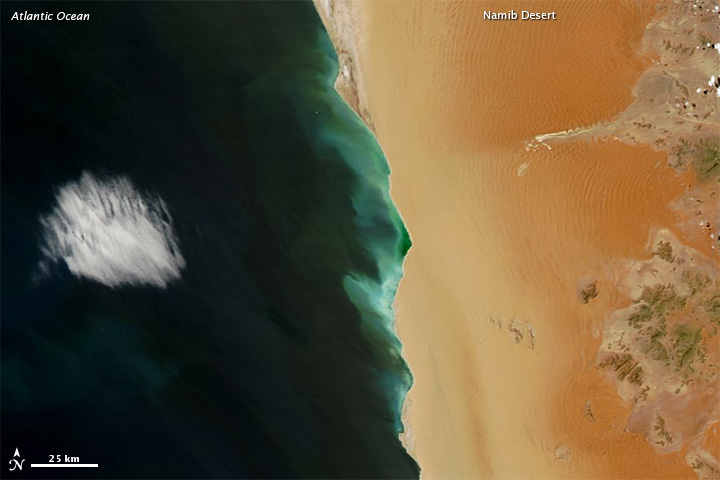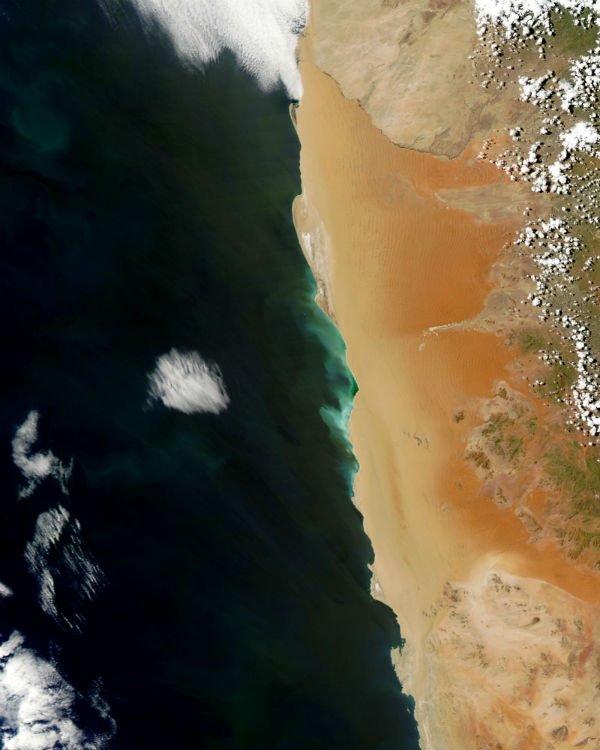Hydrogen sulfide emissions off Namibia coast

Namibian coast was tinted with pale green water in late February 2012. The Namibian Coast has the most intense upwelling of fertile deep-ocean water in the world. Hydrogen sulfide gas is emitted periodically along Namibian coast due ocean currents that carry oxygen-poor water to the region, and chemical and biological processes can deplete what little oxygen is available. The local seafloor sediments are also rich with organic matter and when that matter decays in an oxygen poor environment, hydrogen-sulfide emissions can result. Residents of the region can detect the emissions thanks to pervasive rotten-egg smell. The aroma of rotten eggs is familiar to neighbors of industrial plants, but it can also arise naturally when organic stuff rots in the absence of oxygen, as at volcanic vents.
After processing satellite images dating last few years, the scientific community stay shocked by the frequency, spatial extent, and how long these events could last. The fish kills, combined with the satellite data, have made the giant belches a pressing subject of scientific study.
The shallow sea bottom along the coast is covered with a thick ooze of decomposing diatoms — free-floating plants nourished by the strong upwelling. Upwelling generally makes great fishing, and fishing is Namibia’s third-largest industry, and second-largest source of foreign exchange. As a result of almost continual phytoplankton production, there is massive diatom fallout. Dead diatoms fall through the water, where they are decayed by aerobic bacteria. Anaerobic bacteria take over the decomposition task in the thick, muddy sediment, producing hydrogen sulfide. When the gas enters the water column during an eruption, it separates into hydrogen and sulfur, and the hydrogen atoms combine with oxygen to form water. That reaction removes oxygen from the water, creating deadly low-oxygen conditions. Although hydrogen sulfide is itself a respiratory toxin to fish and marine invertebrates, the reduced oxygen may have greater ecological consequences in the long run.
Hydrogen sulphide occurs frequently in the waters of the inner shelf coastal upwelling area off central Namibia. The area affected coincides with hatching grounds of commercially important pelagic fish, whose recruitment may be severely affected by recurring toxic sulphidic episodes. Both episodic biogenic methane gas-driven advective and molecular diffusive flux of hydrogen sulphide have been implicated as transport mechanisms from the underlying organic-matter-rich diatomaceous mud.

The milky-green colors along Namibia’s coast indicate high concentrations of sulfur and low concentrations of oxygen. Episodes like this aren’t just colorful, they are actually toxic to local marine organisms. Fish die in the low-oxygen water; however, what is deadly for the fish can be good for birds that feed on their carcasses. Likewise, lobsters crawling onto shore to escape the toxic seawater can make meals for locals. And some species of foraminifera—tiny shelled marine organisms—actually thrive in the oxygen-poor sea floor sediments off the Namibian coast. (EarthObservatory)
Hydrogen sulphide and methane emissions on the central Namibian shelf

Commenting rules and guidelines
We value the thoughts and opinions of our readers and welcome healthy discussions on our website. In order to maintain a respectful and positive community, we ask that all commenters follow these rules:
We reserve the right to remove any comments that violate these rules. By commenting on our website, you agree to abide by these guidelines. Thank you for helping to create a positive and welcoming environment for all.